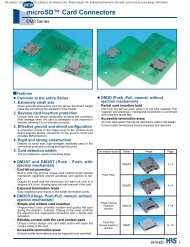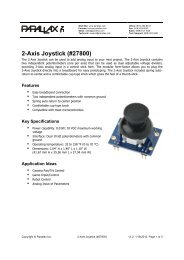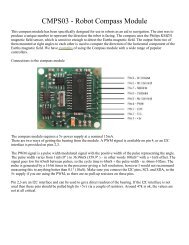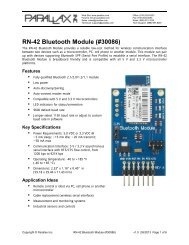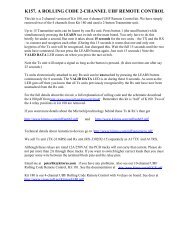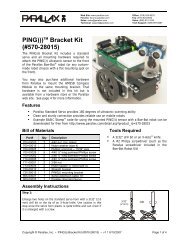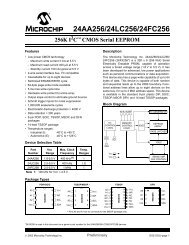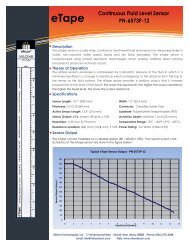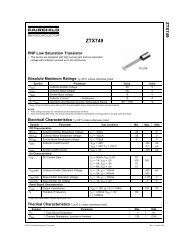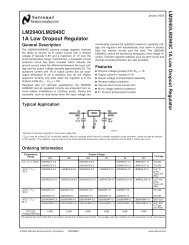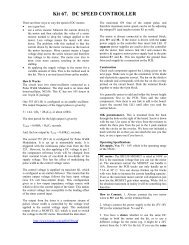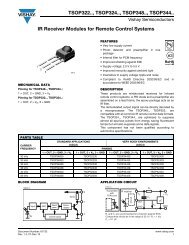Kit 166. Bidirectional DC Motor Speed Controller - PAiA
Kit 166. Bidirectional DC Motor Speed Controller - PAiA
Kit 166. Bidirectional DC Motor Speed Controller - PAiA
- No tags were found...
You also want an ePaper? Increase the reach of your titles
YUMPU automatically turns print PDFs into web optimized ePapers that Google loves.
<strong>Kit</strong> <strong>166.</strong> <strong>Bidirectional</strong> <strong>DC</strong> <strong>Motor</strong> <strong>Speed</strong> <strong>Controller</strong>This kit allows controlling the speed of a <strong>DC</strong> motor inboth the forward and reverse direction. The range ofcontrol is from fully OFF to fully ON in both directions.Normally, switches are used to change the direction ofrotation of a <strong>DC</strong> motor. Change the polarity of the appliedvoltage and the motor spins the other way! However thishas the disadvantage that a DPDT switch has to be addedto change the polarity of the applied voltage. Now youhave two things to control the motor – a direction switchas well as the speed control.Also, it is not a good idea to suddenly reverse the voltageon a <strong>DC</strong> motor while it is spinning. It can cause a currentsurge that can burn out the speed controller. Not tomention any mechanical stress it can cause as well.This kit overcomes both these problems. The direction andspeed is controlled using a single potentiometer. Turningthe pot in one direction causes the motor to start spinning.Turning the pot in the other direction causes the motor tospin in the opposite direction. The center position on thepot is OFF, forcing the motor to slow and stop beforechanging direction.SPECIFICATIONSVoltage: The kit and motor use the same power supply.Since the maximum operating voltage of the LM324 is32V<strong>DC</strong> then this is also the maximum voltage available torun the motor.Current: The IRFZ44 MOSFET can handle 49A; theIRF4905 can handle 74A. However the PCB tracks thatrun from the MOSFET pins to the screw terminal blockcan only handle around 5A. This can be increased bysoldering wire links across the PCB tracks. If you do thencheck that the MOSFETs don’t get too hot – if so thenbigger heatsinks will be required.SPEED CONTROL OF <strong>DC</strong> MOTORSBasically, there are three ways to vary the speed of <strong>DC</strong>motors:1. With the use of mechanical gears to achieve thedesired speed. This method is generally beyond thecapability of most hobbyist home workshops.2. Reducing the motor voltage with a series resistor.However this is inefficient (energy wasted in resistor)and reduces torque. The current drawn by the motorincreases as the load on the motor increases. Morecurrent means a larger voltage drop across the seriesresistor and therefore less voltage to the motor. Themotor now tries to draw even more current, resultingin the motor "stalling".3. By applying the full supply voltage to the motor inbursts or pulses, eliminating the series droppingeffect. This is called pulse width modulation (PWM)and is the method used in this kit. Short pulses meansthe motor runs slowly; longer pulses make the motorrun faster.KIT ASSEMBLYCheck the components supplied in the kit against the partslist. In particular identify the IRFZ44 and IRF4905MOSFETs. They look the same so do not get them mixed.Before mounting any components to the PCB we need toassemble the MOSFETs to the heatsinks. Take an IRFZ44and IRF4905 MOSFET and fit to either side of a heatsink.Loosely secure them together using the supplied 3mmscrew and nut.The MOSFETs need to be perfectly in line with theheatsink. The easiest way to do this is to mount the wholeassembly onto the PCB, making sure that the heatsink pinsand MOSFET leads fit into their respective holes. Don’tsolder anything. Make sure the heatsink is sitting rightdown onto the PCB then tighten the screw and nut. Repeatfor the other assembly then put them aside. They will bethe last items fitted to the PCB.It is recommended that components be inserted andsoldered in the following order:1. All the resistors and diodes.2. The 14 pin IC socket3. Capacitor C3. This fits inside the IC socket. Makesure it doesn’t poke up too high before solderingotherwise it will interfere with inserting the IC intothe socket.4. Transistors Q1 and Q2 and capacitor C1.5. The electrolytic capacitor C2.6. The 2-way screw terminal blocks. These should bejoined together to make a 4-way block beforeinserting into the PCB.7. Potentiometer P18. The previously assembled heatsink/MOSFETmodules. Make sure they are fitted the right wayaround. The IRFZ44 should be facing towards thescrew terminals. Remember to solder the heatsink pinsto the PCB – this is necessary for mechanical strength.9. Fit the LM324 to the IC socket.There is one last thing to do. There are two vias (pinthroughs) on the PCB that need to be filled with solder.One is next to R13 and the other just above Q6. They aremarked with the words “FILL WITH SOLDER”. Thismust be done so that the vias can handle the current.HOW IT WORKS (refer to schematic)The circuit can be broken down in four parts:1. <strong>Motor</strong> control – IC1:A2. Triangle wave generator – IC1:B3. Voltage comparators – IC1:C and D4. <strong>Motor</strong> drive – Q3-6Let us start with the motor drive section, based aroundMOSFETs Q3-6. Only two of these MOSFETs are on atany one time. When Q3 and Q6 are ON then current flowsthrough the motor and it spins in one direction. When Q4Page 1 of 1
<strong>Kit</strong> <strong>166.</strong> <strong>Bidirectional</strong> <strong>DC</strong> <strong>Motor</strong> <strong>Speed</strong> <strong>Controller</strong>and Q5 are ON the current flow is reversed and the motorspins in the opposite direction. IC1:C and IC1:D controlwhich MOSFETs are turned on.Opamps IC1:C and IC1:D are configured as voltagecomparators. The reference voltage that each triggers at isderived from the resistor voltage divider of R6, R7 and R8.Note that the reference voltage for IC1:D is connected tothe ‘+’ input but for IC1:C it is connected to the ‘-‘ input.Therefore IC1:D is triggered by a voltage greater than itsreference whereas IC1:C is triggered by a voltage less thanits reference.Opamp IC1:B is set up as a triangle wave generator andprovides the trigger signal for the voltage comparators.The frequency is approximately the inverse of the timeconstant of R5 and C1 – 270Hz for the values used.Reducing R5 or C1 will increase the frequency; increasingeither will decrease the frequency.The peak-to-peak output level of the triangle wave is lessthan the difference between the two voltage references.Therefore it is impossible for both comparators to betriggered simultaneously. Otherwise all four MOSFETswould conduct, causing a short circuit that would destroythem.The triangle waveform is centered around a <strong>DC</strong> offsetvoltage. Raising or lowering the offset voltage changes the<strong>DC</strong> position of the triangle wave accordingly. Shifting thetriangle wave up causes comparator IC1:D to trigger;lowering it causes comparator IC1:C to trigger. When thevoltage level of the triangle wave is between the twovoltage references then neither comparator is triggered.The <strong>DC</strong> offset voltage is controlled by the potentiometerP1 via IC1:A, which is configured as a voltage follower.This provides a low output impedance voltage source,making the <strong>DC</strong> offset voltage less susceptible to theloading effect of IC1:B. As the ‘pot’ is turned the <strong>DC</strong>offset voltage changes, either up or down depending onthe direction the pot is turned.Diode D3 provides reverse polarity protection for thecontroller. Resistor R15 and capacitor C2 are a simple lowpass filter. This is designed to filter out any voltage spikescaused by the MOSFETs as they switch to supply power tothe motor.HOW TO CONNECTThe motor connects to the M1 and M2 terminals.The power supply connects to the V+ and GND terminals.TROUBLESHOOTINGMost faults are due to assembly or soldering errors. Verifythat you have the right components in the right place.Check that no IC pins are bent up under the body of theIC. This can sometimes happen when inserting ICs intosockets.PARTS LIST – K166Resistors (0.25W carbon film unless specified)100R................................. R15 ...................................... 14K7................................... R9,14 ................................... 210K................................... R2,7,10,11,12,13................. 612K................................... R8 ........................................ 133K................................... R6 ........................................ 147K................................... R3 ........................................ 1100K................................. R1 ........................................ 1220K................................. R4 ........................................ 1470K................................. R5 ........................................ 1100K potentiometer.......... P1 ........................................ 1PCB mountingCapacitors10nF 63V box poly .......... C1 ........................................ 1100nF mono, 0.1” ............ C3 ........................................ 1100uF 63V electrolytic..... C2 ........................................ 1Semiconductors1N4004............................. D3........................................ 11N4148............................. D1,2..................................... 2BC547 transistor .............. Q1,2..................................... 2IRF4905 .......................... Q3,5..................................... 2P-channel Power MOSFETIRFZ44............................. Q4,6..................................... 2N-channel Power MOSFETLM324.............................. IC1....................................... 1Quad opampMiscellaneousIC socket, 14 pin, for IC1............................................... 1Screw terminal block, 2 way.......................................... 2(joined to make a 4-way block)Heatsinks for MOSFETs Q1-4....................................... 2Screw, 3 x 8mm ............................................................. 2Nuts, 3mm...................................................................... 2K166 PCB ...................................................................... 1DATASHEETSIRFZ44, IRF4905 MOSFETs - www.irf.comLM324 quad opamp - www.national.comCONTACT DETAILSFor our full range of kits see our website athttp://www.kitsrus.com<strong>Kit</strong> developer: frank2004@ozitronics.comInspect your work carefully under a bright light. Thesolder joints should have a ‘shiny’ look about them. Checkthat there are no solder bridges between adjacent pads.Page 2 of 2
<strong>Kit</strong> <strong>166.</strong> <strong>Bidirectional</strong> <strong>DC</strong> <strong>Motor</strong> <strong>Speed</strong> <strong>Controller</strong>Page 3 of 3




